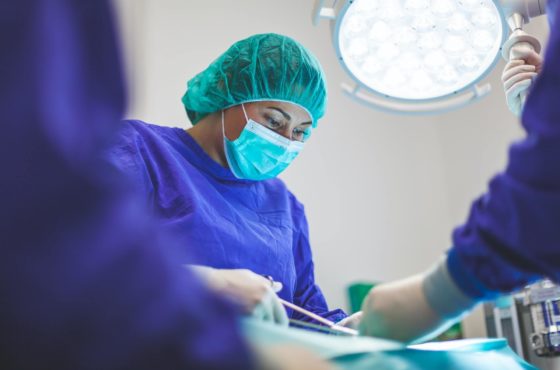A hernia mesh can possibly move after a hernia repair surgery. This complication caused by defective hernia mesh medical devices is also known as mesh migration.
Hernia mesh migration is also one of the cause of complications and injuries cited by plaintiffs in the hernia mesh lawsuit.
When this happens, it can cause severe pain in patients.
The bad news?
Patients can also experience no symptoms until the hernia mesh causes more damage to them.
Continue reading the article to know more about hernia mesh migration: what it really is, how it happens, the damages and injuries this movement of the medical device can cause, and how victims of defective hernia mesh implants can join the legal battle to make abusive manufacturers accountable.
What is Hernia Mesh Migration?
Hernia mesh migration happens when mesh detaches or moves out of place after hernia repair surgery.
As a result, the mesh moves from the surgical site, which is its original spot, to other locations such as surrounding tissue or organs.
It can happen immediately after the procedure, or even years later.
Mesh migration can also happen under two circumstances: primary mechanical migration and secondary migration.
And here’s how they differ:
Primary mechanical migration happens when a surgical mesh with a defective design causes the medical device to not be secured enough to the surrounding tissue. Therefore, it may move.
In some cases, mesh can also be tightly secured to the surrounding tissue at first, but unusual pressure caused by an external force may eventually cause it to move.
This kind of migration happens often sooner after a patient’s surgery, rather than years after.
On the other hand, secondary mesh migration happens as a side effect of inflammation due to our immune response to the mesh implant called foreign body reaction.
This type of mesh migration gradually happens in a span of months or years as the inflammation slowly breaks down the foreign mesh medical device.
Most mesh is made from a type of plastic called polypropylene, including other materials. These materials can also cause inflammation due to an allergic reaction by the body. Moreover, polypropylene mesh, when used in hernia surgeries, has been known to cause more problems compared to other mesh products made up of different materials.
Mesh migration may also lead to bowel obstruction or perforation, mesh adhesions, as well as fistulas and abscesses.
How Do You Know if Your Hernia Mesh has Moved?
Those who suffer from mesh migration may experience signs and symptoms which may be similar to symptoms of mesh failure, such as:
- fever and/or chills with an unknown cause
- nausea and/or vomiting
- mild to severe pain
- feeling of warmth on the surgical site
- inability to pass gas or stool
- improper healing of the wound from surgery
- fluid buildup at the surgical site (seroma)
- redness, pain, or swelling at the site of incision
- chronic pain
According to the BBC, some patients have also reported of long-term side effects following hernia surgery involving the use of mesh, including chronic infections, pain that affects mobility, as well as stress and emotional suffering.
Can Mesh Used in Hernia Repair Move Years Later?
In general, hernia repair surgery is considered to be safe.
However, it is still possible for those who have undergone this surgery to experience problems even years later.
According to the U.S. Food and Drug Administration (FDA), the most common adverse effects that develop after hernia repair with the use of mesh include pain, infection, bowel obstruction, adhesion, mesh migration, and recurrence.
Mesh migration or shrinkage may also lead to severe or chronic pain and damage to a patient’s internal tissue.
According to a 2017 study, hernia repair surgery is one of the most common yet major procedures done worldwide, with 20 million hernia surgeries done globally each year.
According to the researchers, the use of mesh in surgeries such as hernia mesh repair has been widely adopted in the United States, with more than 80% of hernia repairs performed in the country making use of mesh products.
However, a study published in 2016 said, “nearly a third of patients experienced complications or needed additional surgery more than five years after the surgical mesh was implanted.”
The good news?
Today, an increasing number of people are joining the legal battle against hernia mesh manufacturers. These people have suffered from pain and serious complications following a repair surgery.
If you or your loved one experienced symptoms of complications immediately after your surgery, or perhaps you are an unsuspecting patient who did not have symptoms until years after the procedure, you may be eligible for compensation.
Filing a hernia mesh lawsuit today will be a stepping stone to achieve that goal.
Call us today and we will provide you with the next legal steps you can take to fight for your rights.
Complications of Mesh Migration
The complications caused by mesh migration can vary depending on the site of surgery and the kind of mesh product used.
But in general, mesh migration can cause infection, unusual bleeding, chronic pain, hernia recurrence, and fistula formation, or the abnormal connections between two parts of the body.
Even though considered rare, in severe cases of mesh migration, the device may become free from any tissue and instead become a meshoma or shrinkage mesh in form of a ball or rounded mass.
This can negatively affect the surrounding tissue which can then lead to nerve damage and chronic pain.
These injuries may later on require long-term pain management.
What Keeps Hernia Mesh in Place?
Hernias occur when there is a weak spot in the wall of a muscle or a tissue, causing an internal organ or other body parts to protrude or squeeze through.
Inguinal hernia is the most common type of hernia. An inguinal hernia occurs in the abdomen near the groin area. It develops when fatty or intestinal tissues push through the inguinal canal, a passage in the lower layers of the abdominal wall.
“Sometimes a hernia can be visible as an external bulge particularly when straining or bearing down,” the U.S. Food and Drug Administration states.
In order to fix a hernia, a patient needs to undergo a procedure called hernia repair surgery.
This surgery is most often the only way to permanently fix this medical condition. Majority of these repairs done in the United States make use of the mesh.
The mesh is preferred by surgeons as they believe it may improve one’s outcome. The use of these medical devices was also found to help decrease both the time in doing the surgery and the time of recovery.
In a repair surgery, surgeons put mesh over the open hernia. To hold the mesh in place, doctors use sutures or glue intended for surgery.
As time goes by, the patient’s tissue should grow through the small pores of the mesh and further strengthen the muscle wall. This process creates scar tissue that strengthens the site of hernia.
However, the procedure is not completely fool-proof.
Other factors like the type of mesh used, the approach used in the surgery, and the patient’s medical condition can play a role in the overall success of the repair surgery.
Some types of mesh have actually been recalled due to higher failure rates which led to serious complications and the need for additional surgery.
What are the Symptoms of Hernia Mesh Failure?
Failure means that the surgical mesh used in your hernia repair surgery failed to fulfill its purpose as it should have.
Possible reasons for mesh failure may be because of a defective hernia mesh product and its bad design or wrong and incompatible mesh material. It may also be caused by a surgeon’s errors.
You can tell of your hernia mesh has failed if you experience these symptoms immediately or even years after your hernia surgery:
- high fever
- nausea and vomiting
- excessive pain
- bruising and swelling
- warm or hot skin in the surgical site
- bulging in the area where the mesh was implanted
- difficulty urinating
- inability to pass gas or stools
Once you happen to notice these changes in your body, you should talk to your doctor as soon as possible.
The symptoms and risks associated with hernia mesh surgeries can be difficult for a patient alone to recognize or diagnose.
You should tell your doctor that you are having these symptoms and that you had a hernia repair surgery.
Hernia Mesh Complications
Complications from the mesh include pain and discomfort, adhesion, bowel obstruction or perforation, recurrence, infection, mesh migration, and rejection.
After a repair surgery, patients have complained about symptoms including pain, as well as their hernias coming back.
The most serious complications following repair surgery are also some of the most common ones.
According to the FDA, the most common hernia mesh complications include:
- bowel perforation
- bowel obstruction
- adhesion
- mesh infection
- rejection
- mesh migration
- chronic pain and discomfort
- hernia recurrence
Among these complications, chronic pain is the one complication that people complain about the most. According to a study, nearly one-third of patients who undergo hernia repairs experience this complication.



